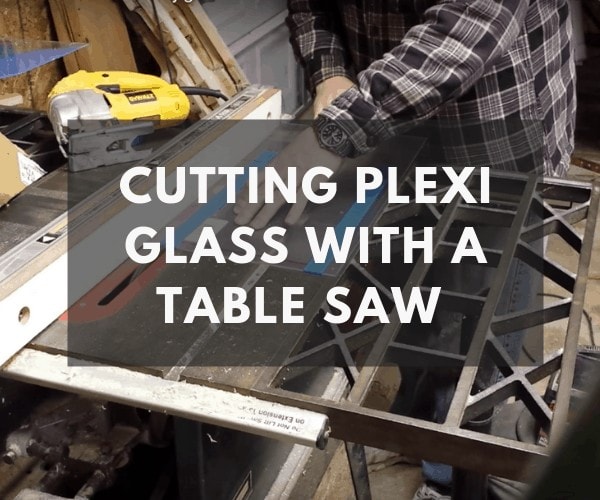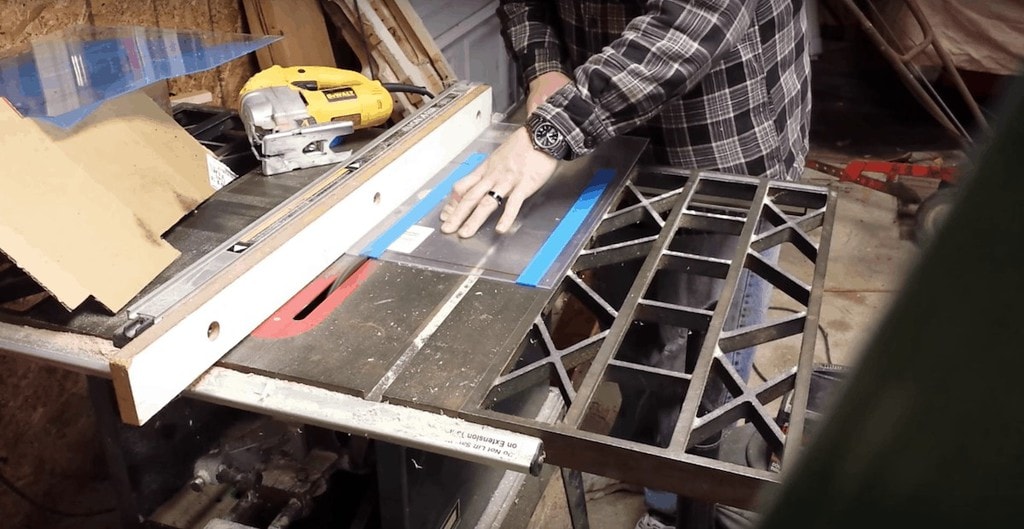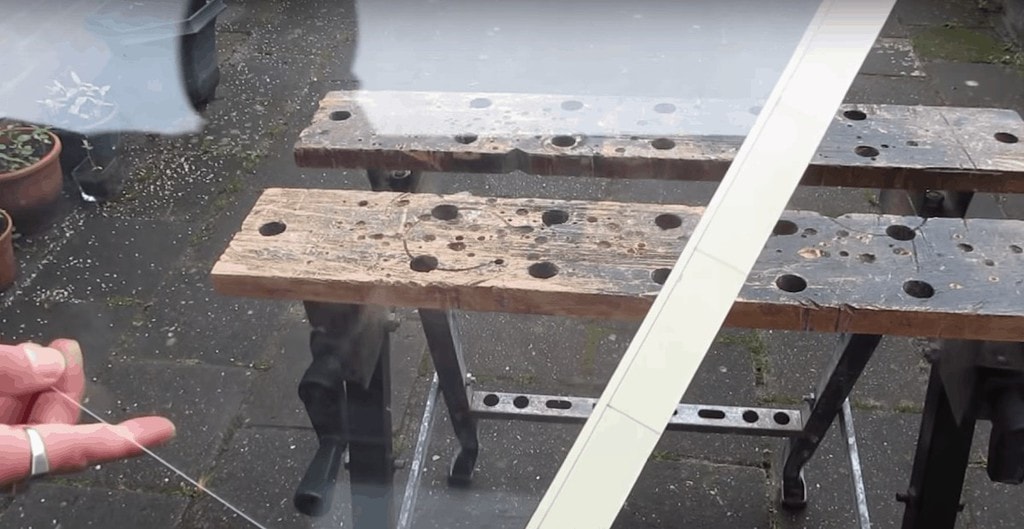Plexiglass and other acrylic sheeting are an inexpensive alternative to glass in many household projects, but finding an effective way to cut down sheets of it can be troublesome. Plexiglass is prone to chipping and cracking when being cut into.
So, can you cut plexiglass with a table saw? Yes, a table saw can be used to cut plexiglass and other acrylic materials if a saw blade designed for plastic is used and the proper technique is employed.
A table saw is one of the easiest ways to cut through a sheet of plexiglass or other acrylic material, but it does require some special handling. Continue reading to learn more about the supplies you will need and the technique you need to use when cutting plexiglass.
Supplies for Cutting Plexiglass with a Table Saw
Cutting plexiglass with your table saw requires a few extra supplies that you wouldn’t normally use when cutting wood, the most important of which is a special blade that allows you to cut through plastic materials.
Is it Plexiglass? Not all acrylic sheets are the same, and not all of them can be cut with a table saw without significant melting.
There are two types of acrylic sheets:
- Cast acrylic
- Extruded acrylic
Cast acrylic sheets are what most people think of when they think of plexiglass. They are hard and can usually be cut with a table saw without melting as long as the right blade is used. Cast acrylics tend to cost much more than the others.
Extruded acrylic sheets are softer and have lower melting temperatures and generally should not be cut with power tools at all. It is usually better to use a score and snap method with this kind of plastic sheeting. The benefit of extruded acrylic sheets is that they can be molded using heat.
Polycarbonate sheets are another type of plastic sheeting. Polycarbonate sheets can be cut with table saw taking extra care. They are a softer material than plexiglass and may require some experimentation before you get the hang of what blade to use and how to feed the sheet through the table saw.
In short, before you start cutting plexiglass make sure you have the right material.
Plexiglass Strength
If you’re looking for strength, you are definitely going to want to make sure you have real plexiglass. Here are the results of impact resistance tests done on Plexiglas brand plexiglass and different kinds of standard glass (source).
Impact Resistance of Plexiglas vs Glass
Product | Nominal Thickness (in) | Weight of free-falling steel ball (lb.) | F50 Energy to Break Product |
|---|---|---|---|
Plexiglas Sheet | .098 | .25 | 3.0 |
Plexiglas Sheer | .236 | 5 | 18.1 |
Window Glass, single strength | .1 | .25 | .8 |
Plate Glass | .250 | .25 | 2.0 |
Laminated Glass | .250 | .25 | 1.1 |
You can easily see here that plexiglass is far superior to glass when it comes to impact resistance. It took a five-pound steel ball far more energy to break through the thickest plexiglass than it took a ¼ pound steel ball to break through a piece of glass that was even thicker.
Table Saw
While any table saw could likely cut through plexiglass with the right blade installed, it is recommended that the table saw be equipped with at least a 10” blade and a 2-horsepower motor. Additionally, the blade should be running at a speed of approximately 3,450 RPM, if that is possible.
Blade
Picking out a good blade for cutting plastic can be a little challenging. The best blades for cutting plastic have between 60 and 80 evenly spaced, carbide tipped teeth depending on the diameter of the blade. The blade should have no rake and uniform teeth.
Softer plexiglass may require a blade with fewer teeth to prevent burning, while harder plastics will require more teeth to prevent chipping.
There are blades specifically made for cutting plastic, but depending on the kind of plastic you are trying to cut, the results of these blades will vary.
Safety
Safety goggles should be worn whenever you’re using a table saw, but you will definitely need to wear them when cutting plexiglass. Shards of plastic can shoot out from the saw blade and straight back at your face.
Technique for Cutting Plexiglass with a Table Saw
The overall process of cutting a piece of plexiglass is not so different from cutting wood, but there are some small details to consider in order to improve the quality of the finished product and to keep yourself safe.
- Change the blade in your table saw to a blade that is meant for cutting through plastic.
- Set the blade height so it is only ½ inch higher than the piece of acrylic sheeting.
- Measure and mark the plexiglass.
- You do not need to remove the protective film on the plexiglass. This will help prevent it from getting scratched.
- Place the plexiglass on the table saw with the film side down and set everything up the same way you would for cutting a piece of wood. Be sure it is tight to the fence.
- Put on your safety glasses, turn the saw on, and slowly feed the acrylic sheet to the saw using a push stick.
Feed Rate
The recommended manual feed rate should be about 3 inches per second, and you should move at a steady place. It doesn’t have to be exact, just a steady and slow push. You may need to move more slowly if the sheet is on the thinner side.
Apply Pressure
Be sure that the acrylic is tight against the fence and apply pressure as you push it forward, especially if the piece of acrylic you’re working with is thin. Thin acrylic will have a tendency to vibrate, which is potentially dangerous.
Cross Cutting
Cross cutting acrylic can be challenging because acrylic tends to chip at the corners. It can sometimes help to start the cut at one end, flip the piece of acrylic, and finish the cut coming from the other side.
How to Sand Acrylic
After you cut the acrylic, the edge will likely be rough, or it might even be slightly glazed from the heat of the blade. To fix this, you will need to sand the edge.
- Put 120 or 180 grit waterproof sandpaper on a sanding block.
- You can transition to finer grit sandpaper as the plexiglass gets smoother and smoother.
- The final sandpaper should be a 600-grit sandpaper, and it will provide a very smooth finish.
- If you want an extra smooth finish you can buff it out with a buffing pad attached to an electric drill.
Note: A polished acrylic edge cannot be glued. If you plan to glue the edge, then you should not create a polished edge.
Other Ways of Cutting Plexiglass
While cutting plexiglass with a table saw is a great option, it might be a little overkill for whatever you’re doing. Generally, thinner pieces of plexiglass can be cut using different equipment. This is safer as thin pieces of plexiglass can be prone to kickback on a table saw.
Here are some other ways of cutting plexiglass that do not involve a table saw.
Plexiglass Knife or Utility Knife
This method is best used with thin pieces of plexiglass up to ⅛ of an inch thick. Use the knife to score the plexiglass along a straight edge. Make 8 to 10 passes with the knife. You can then snap the plexiglass along the score.
Dremel Grinder with Cutting Wheel
If you need to make irregular cut in the plexiglass, a Dremel grinder with a cutting wheel can cut through thin pieces of plexiglass easily.
Jigsaw
For plexiglass of any thickness you can use a jigsaw with a plexiglass blade to make straight or irregular shaped cuts.
Circular Saw
Like the jigsaw, a circular saw with a blade meant for cutting plexiglass can also cut through plexiglass of any thickness. This will cut very similar to the table saw.



